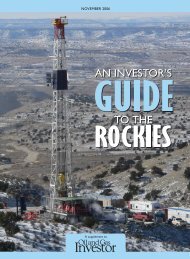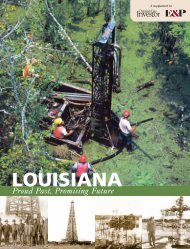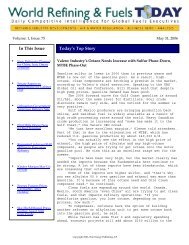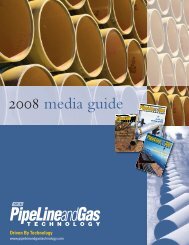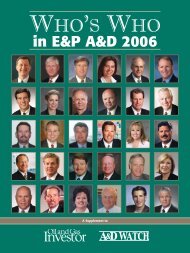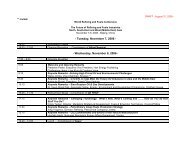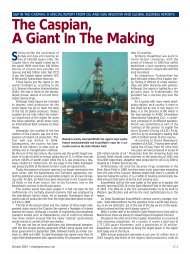ASTM: Gasoline Today and Tomorrow – An Executive Report
ASTM: Gasoline Today and Tomorrow – An Executive Report
ASTM: Gasoline Today and Tomorrow – An Executive Report
Create successful ePaper yourself
Turn your PDF publications into a flip-book with our unique Google optimized e-Paper software.
Octane Week | <strong>ASTM</strong>: <strong>Gasoline</strong> <strong>Today</strong> <strong>and</strong> <strong>Tomorrow</strong> - <strong>An</strong> <strong>Executive</strong> <strong>Report</strong><br />
(from p15) in <strong>ASTM</strong> <strong>and</strong> thus their greater voting<br />
power, Subcommittee D02.A leaders wisely garnered<br />
support around a 4 ppm spec <strong>and</strong> brought the issue to<br />
closure last week.<br />
“Weʼve got a number, 4 ppm, <strong>and</strong> we have test<br />
methods. Thatʼs a great accomplishment,” said Ben<br />
Bonazza, D02 Committee chairman.<br />
Refining <strong>and</strong> auto groups will now try to move the<br />
specification limit lower. Most of the ethanol that is<br />
produced <strong>and</strong> marketed in the U.S. can easily meet the<br />
4 ppm spec, our source told us. It is only the occasional<br />
batch of domestic ethanol <strong>and</strong> some imported material<br />
than can have trouble meeting the new specification.<br />
Will the spec move lower? Maybe, but not now.<br />
“The current specification is a triumph of testing<br />
<strong>and</strong> compromise, <strong>and</strong> deserves support”, our source<br />
continued. “But anything that will reduce the levels<br />
of impurities in refining fuel feedstocks is good. <strong>An</strong>d<br />
ethanol producers are doing the right thing. They are<br />
working with refiners to facilitate the use of their<br />
product.”<br />
<strong>–</strong> Carol Cole<br />
Busy <strong>ASTM</strong> Agenda Includes Debates On DI, Ethanol Sulfates<br />
From the June 13, 2005 edition.<br />
<strong>ASTM</strong> members gathering in Pittsburgh, Pa., in<br />
June 2005 will be facing an agenda full of gasoline<br />
quality issues, some familiar, some new. The D02<br />
Committee on Petroleum Products will investigate<br />
particulate contamination in gasoline <strong>and</strong> diesel to<br />
determine whether a retail spec should be set. Committee<br />
members also will delve into the issue of ethanol sulfate<br />
content, now that individual refiners are setting their<br />
own specs to control sulfates.<br />
Ethanol is creeping into <strong>ASTM</strong> discussions<br />
more frequently. As the fuels industry prepares for<br />
a possible renewable fuels st<strong>and</strong>ard, which will<br />
m<strong>and</strong>ate substantially more ethanol use, questions<br />
about the additiveʼs quality <strong>and</strong> blending traits become<br />
increasingly important.<br />
Some <strong>ASTM</strong> members are concerned that the<br />
<strong>ASTM</strong> Subcommittee Wrestles With DI Change;<br />
Retail Spec Proposed<br />
existing Distillation Index (DI) equation needs an<br />
ethanol term. The current T10, T50 <strong>and</strong> T90 terms<br />
do not adequately reflect a blendʼs distillation when<br />
ethanol is present, they say. CRC test results will be<br />
evaluated in an effort to determine whether an ethanol<br />
term is needed.<br />
Committee members also will return to more<br />
familiar territory, such as whether to apply the test DI<br />
at the retail level rather than at the refinery, where it is<br />
currently applied. DI is the only <strong>ASTM</strong> specification<br />
that is not applied at retail.<br />
Silver corrosion is also on the <strong>ASTM</strong> agenda. The<br />
emergency test method that was adopted last year will<br />
be reviewed, <strong>and</strong> members will evaluate whether more<br />
round robin testing is needed before a permanent test<br />
method is selected.<br />
<strong>–</strong> Carol Cole<br />
Coverage of the <strong>ASTM</strong> Subcommittee meeting appeared<br />
in the July 5, 2005 issue.<br />
Adding an ethanol term to the <strong>ASTM</strong> Driveability<br />
Index (DI) equation will more accurately reflect the effect<br />
of ethanol on gasoline cold-start <strong>and</strong> warm-up driveability,<br />
supporters of the change said. <strong>An</strong> ethanol term is not<br />
needed <strong>and</strong> will make gasoline more costly to produce,<br />
opponents countered. This controversial issue was to be<br />
“balloted” to determine whether members of <strong>ASTM</strong>ʼs D-<br />
02.A gasoline subcommittee support the change.<br />
<strong>ASTM</strong> considered adding an ethanol term to DI<br />
for years, <strong>and</strong> various offsets had been discussed. The<br />
Coordinating Research Council (CRC) has participated<br />
in the effort to quantify the impact of ethanol on fuels<br />
<strong>and</strong> vehicle operation. Early CRC studies showed that<br />
equal DI, ethanol blends generally have been shown<br />
not to perform as well.<br />
The latest CRC research indicated an offset for<br />
ethanol was needed in the DI equation, said Driveability<br />
Task Group Chairman Win Gardner of ExxonMobil.<br />
“CRC data supports the addition (continued on p17)<br />
16 February 2007



